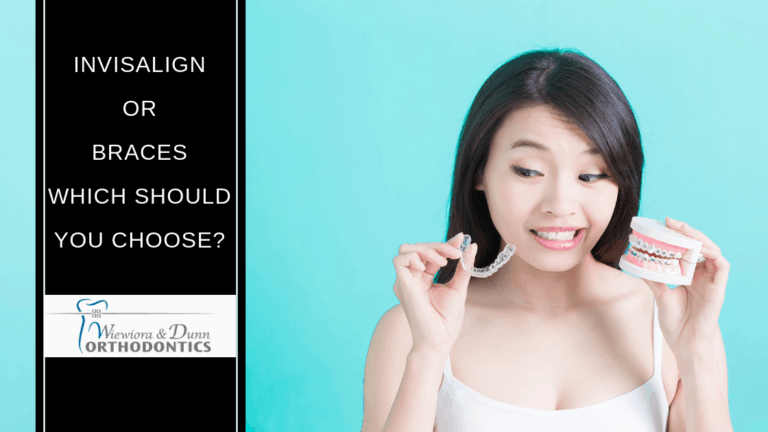Since the launch of Invisalign in 2000, over five million people, including more than one million teenagers, have used Invisalign clear aligners to transform their smiles. While this option has introduced a revolutionary method of treatment, many question whether Invisalign or traditional braces are better.
At Wiewiora and Dunn Orthodontics, we offer both Invisalign and traditional braces for the safe and efficient treatment of misaligned teeth and improper bite. We are proud to be a Gold Plus member of Invisalign, a status achieved by treating many Invisalign cases. Learning about the advantages and limitations of each will make you better informed during your initial consultation.
Benefits and Drawbacks
In deciding which treatment avenue to take, there are pros and cons to each option. Most often, these vary based on the age of the patient. Adults are often concerned with budget, while teens tend to focus on their self-image. While the choice between traditional braces and Invisalign can be difficult, consider which of these areas are more important to you.
Although the choice is ultimately up to you, give serious consideration to your orthodontist’s recommendation. Your doctor recommends a particular course of treatment based up his or her knowledge of the advantages and limitations of each technology, and your unique situation. Traditional braces have the advantage in treating more complex issues – such as teeth that are crowded, crooked, protruding or with irregular spacing – that Invisalign can not.
Well-known to consumers, Invisalign heavily appeals to those who prefer comfort and aesthetics. The shell is thin and invisible when worn, versus comparatively bulky metal braces. Transparent and compact, Invisalign aligners slide on and off with ease and minimal discomfort. Patients will still experience some soreness as their teeth shift, but will not experience the tissue injury associated with traditional braces. This means less risk of bruising, irritation and bulky wax to reduce abrasive contact. It is important to note however, that due to the ease of removal, patients who opt for Invisalign must be diligent in wearing their aligners.
One of the most important aspects of braces versus Invisalign is how your oral hygiene practices can impact your results. Regular brushing and flossing is still required, even more so with traditional braces. As metal brackets are attached directly to each tooth and connected with an archwire, your reach can be limited. Without proper care, patients can experience gum disease or tooth decay from trapped food particles.
For many, time and visit requirements may rank high on the list. Metal braces must be tightened by your orthodontist every month. Invisalign aligners are changed every two weeks, and visits are every four to six weeks. The overall time required to reach correction varies based on the level of alteration necessary, and a patient’s commitment to the orthodontist’s instructions. Metal brace bands should be worn as directed, and aligners for 22-to-24 hours a day.
Invisalign is well-known for its ability to be easily removed – which provides convenience for eating foods that would get stuck between traditional braces. As long as you brush after meals and before re-inserting your aligner, there are no food restrictions. Metal braces, however, come with a full list of foods to avoid – not only for potential damage to the hardware, but because they can make cleaning difficult.
Once the braces are removed, contrast may be visible if teeth have become discolored by demineralization of the enamel that can occur. Invisalign, however, can be completely removed for regular oral hygiene. However, it is important that the aligner itself be rinsed before inserting, and soaked once a day. Any food particles left to rest between the aligners and teeth creates a potential for cavities.
Comparing Prices
One of the most frequently asked questions is how much each treatment method will cost. The price for traditional braces can range between $1,800 to $5,000, whereas Invisalign or clear braces cost an average of $5,000. Keep in mind that these are only general price ranges. Each patient’s cost of treatment will fluctuate depending on the type and complexity of correction necessary. Wiewiora and Dunn Orthodontics offers flexible payment options that we will be glad to discuss with you.
Again, only an orthodontist can determine the best course of treatment. Dr. Cara L. Wiewiora and Dr. Rick M. Dunn treat patients at our Lake Mary and Longwood offices. Our practice is well-equipped to address a diverse range of orthodontic challenges, and provides the most up-to-date procedures, equipment and technology. Contact us today to schedule a free consultation.





